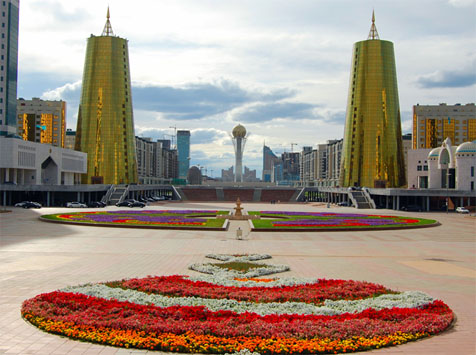kazakhstan
Astana is the capital of
the Republic of Kazakhstan since December 10, 1997. The city's
population as of January 1, 2011, amounted to 697 257
inhabitants . The city is the second in the country by
population after the Almaty.
Former name of the city was Akmolinsk (from 1830 to 1961),
Tselinograd - from 1961 to 1992, Akmola - from 1992 to 1998.
In 1992 - the city was renamed Astana. The word "Akmola" in
Kazakh language means "white grave" or "White Shrine." This is
because about 20 kilometers from the town of the same name the
tract, on top of white limestone hill which has a local grave
beating.
May 6, 1998 Decree of the President of Kazakhstan, "considering
the request of local executive and representative bodies, the
wishes of the public city Akmola and a conclusion by the State
onomastic commission under the Government of the Republic of
Kazakhstan," the city of Akmola was renamed Astana.
Akmola officially was declared the capital of Kazakhstan,
December 10, 1997. International representation of Akmola as the
new capital was on 10 June 1998, but the day of the capital
Astana was moved to on July 6, on the day of the birth of the
first President of the Republic of Kazakhstan - Nursultan
Nazarbayev. Capital Day is a public holiday. At present, Astana
- is fairly large city, an area of 700 square meters. km.
After gaining capital status and organization of a special
economic zone "Astana - new city" in the city realized a lot of
modern architecture and urban planning projects. The population
increased from 270 thousand in 1996 to 600 thousand in 2006.
In 1999, Astana by UNESCO awarded the title "city of
peace." Despite the capital status, the city is still largely
inferior to the infrastructural capabilities of the former
capital of Kazakhstan - Almaty, which kept the capital's
mentality and the city is an unofficially called "southern
capital".
Sights of Astana
The main idea of
construction of Astana is embodiment of the architecture the
combination of rationality of the West and sophistication of the
East, the grandeur of Europe and Asian originality. In the
construction of the city to change its image the most advanced
technologies and innovative methods of urban art of the 21st
century were used. Internationally renowned architects embodied
in the reality of their best projects. This was the springboard
for the left bank of the Yesil River, which until recently was
empty. On a completely uninhabited area began
construction of magnificent buildings of the new capital.
Bayterek
Bayterek is a tourist attraction and here you can meet many
tourists and locals as well. Bayterek is a symbol
of Astana and it epitomizes its being selected as a capital
city. Bayterek can be used as observation tower as well. 105
meters high skyscraper crowned with a gold sphere(egg) with a
diameter of 22 meters.
Unique design is
ebmodiment of folktale of a life tree and a bird of happiness.
The sacred bird Samruk flies with huge wings covering the
sky. It tends to Baiterek, the tree of life, to lay a golden egg
- the Sun, giving life and hope. And below, at the roots, hungry
dragon Aydahar is waiting its time calling night to shift day,
winter to replace summer. So is the eternal struggle between
good and evil.
Observation deck is
nestled in 97 meters hish in golden sphere. Why 97 meters high
not 100? Because it symbolizes the year 1997 when Astana was
entitled the status of capital of country.
Observation platform contains large aquarium and
an art gallery.
Palace of Peace and Reconciliation
The international
organization UNESCO awarded Astana the title of "City of
Peace". In 2001 Pope John Paul II visited Astana, thereby
assessing the contribution of Kazakhstan to the decision of
religious issues. Especially for the "Congress of Leaders of
World and Traditional Religions," was built Palace of Peace and
Accord - a unique pyramid-shaped building. Pyramid rightfully
recognized as a center of religious studies and religious
tolerance. Hall "Cheops Atrium" fascinating and noble white
marble. In the pyramid there is a concert and opera hall,
equipped with the latest equipment.
The building was built
in 2006 and it was designed by British architects. For the
construction of the pyramid 58 mln. was spent.
The Pyramid was
specially constructed to host the Congress of Leaders of World
and Traditional Religions. A 1,500-seat opera house is built
into the lower levels, with auditorium and performance equipment
design by Anne Minors Performance Consultants and acoustics by
Sound Space Design.
Duman Entertainment Center
The Entertainment Centre
“Duman” began its activity in May, 2003, and nowadays it
presents a unique complex of entertainments which consists of an
Oceanarium with tropic fish, 5D Motion Theatre, video arcade,
bowling, night club, hotel, cafes and restaurants.
Kabanbai Batyr Ave. 4,
Astana, 010000
tel.: +7 7172 24 22 22, 24 24 85
fax: +7 7172 24 24 90
e-mail:duman@duman.kz
web: www.duman.kz
Atameken
Ethno-Memorial Complex
Atameken Ethno-Memorial
Complex was opened on September 8, 2001 by the initiative of the
president of Kazakhstan. Ethno-memorial complex covers an area
of 1.7 hectares. On the map there are 14 provinces
and two cities of Astana and Almaty.
Cognitive Ethno-Memorial
Complex "Map of Kazakhstan" Atameken " will acquaint you with
the history of the state, the culture of the peoples inhabiting
in Kazakhstan. Interesting part of the map of Kazakhstan
"Atameken" is decorative - formalized model of the Caspian Sea.
Traveling along the paths of maps that correspond to the main
roads and railways of the country, will explore the most
important sights of Kazakhstan.
Kabanbai Batyr
Molodezhni Microdistrict Astana
Kazakhstan
221 636












